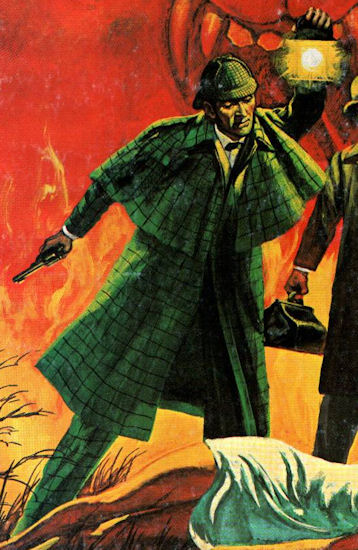 Real Name:
Sherlock Holmes
Real Name:
Sherlock Holmes SHERLOCK HOLMES
 Real Name:
Sherlock Holmes
Real Name:
Sherlock Holmes
Identity/Class: Human;
(late
19th-early 20th
century);
British
citizen
Occupation: Consulting detective
Group Membership: None
Affiliations: Cartwright,
Sir
Henry Baskerville, Mrs. Hudson, Inspector
Lestrade, Dr.
James Mortimer, Dr.
John Watson, Wiggins;
possibly Rawhide Kid (Johnny Clay) (see comments)
Enemies: The Hound of the Baskervilles, the Machiavelli Club (Fu Manchu, Professor James Moriarty, Ra's Al Ghul, others - see comments), Dr. Grimesby Roylott, Jack Stapleton, Von Bork
Known Relatives: Mycroft Holmes (brother), unidentified grandmother, Émile Jean-Horace Vernet (grand-uncle), Clive Reston (alleged great-nephew), unidentified niece (Clive's mother)
Aliases: None
Base of Operations: A cottage on the South
Downs, Sussex;
formerly 221B Baker Street, London, U.K.; unspecified flat
in Montague Street, London, U.K.
First Appearance: "A Study in Scarlet," Beeton's
Christmas Annual 1887 (November 1887);
(referenced as an actual
person in Marvel) Giant-Size Master of Kung-Fu#3 (March 1975);
(appeared/adapted in a
Marvel title) Marvel Preview I#5 (April 1976)
Powers/Abilities: Sherlock Holmes possessed extraordinary deductive reasoning skills, fueled by his keen perception of even the tiniest of details and an encyclopedic knowledge of numerous and frequently esoteric topics. His knowledge was deliberately focused to whatever topics he perceived to be relevant to solving crimes; hence he could tell on sight where in London a specific type of soil might originate or discern between hundreds of different types to ash to identify what someone smoked, but had no clue, nor desire to learn, about even the most basic astronomy. His senses were abnormally acute.
Despite never taking exercise for its own sake, viewing aimless bodily exertion a waste of effort, and being exceptionally thin, he was inordinately strong, able to bend iron bars with relative ease, and possessed incredible stamina, going for days without sleep or food while immersed in a case. Though he viewed exercise so negatively, he would regularly train in skills he viewed as relevant, not only intellectual training to improve his deductive skills, but also fencing and single-stick fighting, being an expert in both. He had the skill to be a prizefighting boxer, had he been so inclined, and was trained in an obscure form of Japanese wrestling Baritsu (see comments).
Holmes was an expert at disguise, able to alter his appearance, voice, accent and mannerisms through make-up and acting to the extent that he could easily deceive even his closest friends.
Height: 6'
Weight: 145 lbs. (by approximation)
Eyes: Grey
Hair: Black
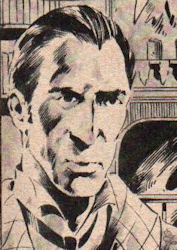 History: (novels and short stories) - Born around
1854, Sherlock Holmes and his elder brother Mycroft were geniuses who
developed incredible skill at deductive reasoning as a means of mental
stimulation and competition between them, figuring out details about
people from observing tiny clues others would overlook or fail to
comprehend. Though smarter than his brother, Mycroft was physically
lazy, and went into working for the government, where his prodigious
memory enabled him to serve as a human database for government policy in
an era long before computers were developed. Sherlock took a different
path; at university he realized that a profession might be made out of
what he had till then considered a mere hobby, the science of
observation and deduction, when a classmate's father told him that all
detectives of fact and fiction would be children compared to him. Talk
of his methods amongst his fellow students resulted in the occasional
case coming his way while he finished his studies, effectively launching
his career.
History: (novels and short stories) - Born around
1854, Sherlock Holmes and his elder brother Mycroft were geniuses who
developed incredible skill at deductive reasoning as a means of mental
stimulation and competition between them, figuring out details about
people from observing tiny clues others would overlook or fail to
comprehend. Though smarter than his brother, Mycroft was physically
lazy, and went into working for the government, where his prodigious
memory enabled him to serve as a human database for government policy in
an era long before computers were developed. Sherlock took a different
path; at university he realized that a profession might be made out of
what he had till then considered a mere hobby, the science of
observation and deduction, when a classmate's father told him that all
detectives of fact and fiction would be children compared to him. Talk
of his methods amongst his fellow students resulted in the occasional
case coming his way while he finished his studies, effectively launching
his career.
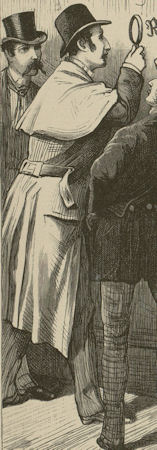 Around 1878 he became a consulting detective,
styling himself as "the last and highest court of appeal in detection.
When [Scotland Yard's detectives] are out of their depths - which, by
the way, is their normal state - the matter is laid before me. I examine
the data, as an expert, and pronounce a specialist's opinion. I claim no
credit in such cases. My name figures in no newspaper. The work itself,
the pleasure of finding a field for my peculiar powers, is my highest
reward." Initially his practice grew slowly, but the various Scotland
Yard detectives soon came to know he was a useful person to enlist when
tricky cases arose. In 1881 he moved from his accommodation in Montague
Street to a flat (apartment to Americans) in London at 221B
Baker Street, but found he needed someone to split the rent with, so a
mutual acquaintance, Stamford, introduced him to Doctor John H. Watson,
recently retired from the British Army after being wounded while serving
in Afghanistan. Watson swiftly became Holmes closest friend, as
well as his official biographer, accompanying him on many a case.
Around 1878 he became a consulting detective,
styling himself as "the last and highest court of appeal in detection.
When [Scotland Yard's detectives] are out of their depths - which, by
the way, is their normal state - the matter is laid before me. I examine
the data, as an expert, and pronounce a specialist's opinion. I claim no
credit in such cases. My name figures in no newspaper. The work itself,
the pleasure of finding a field for my peculiar powers, is my highest
reward." Initially his practice grew slowly, but the various Scotland
Yard detectives soon came to know he was a useful person to enlist when
tricky cases arose. In 1881 he moved from his accommodation in Montague
Street to a flat (apartment to Americans) in London at 221B
Baker Street, but found he needed someone to split the rent with, so a
mutual acquaintance, Stamford, introduced him to Doctor John H. Watson,
recently retired from the British Army after being wounded while serving
in Afghanistan. Watson swiftly became Holmes closest friend, as
well as his official biographer, accompanying him on many a case.
(Marvel Preview#5 (fb) - BTS) - In April 1883 Holmes was hired by Helen Stoner, who suspected her step-father, Dr. Grimesby Roylott, had somehow murdered her older sister, Julia, and was now meaning to kill her too, so he could steal their late mother's money. Helen had found her dying sister in her bedroom, locked and barred from the inside, and showing no signs of violence, with the only clue to what had befallen her being his last words, "the speckled band"; Roylott had now moved Helen into Julia's old room. Correctly deducing how Roylott had committed his first and was intending to commit his second murder, Holmes had Helen sleep in a different room and while he and Watson waited in Julia's room until Roylott slipped a lethal swamp adder, the "speckled band" Julia had seen in the darkness, in through a ventilator.
(Marvel Preview#5 (fb)) - Attacking the snake with his cane, Holmes drove it back through the ventilator into Roylott's room...
(Marvel Preview#5 (fb) - BTS) - ...and the enraged
animal bit its master, ending his villainous life.
Introduced by Dr. Mortimer to Sir Henry after the latter's arrival in London, Holmes learned that an anonymous letter had been left for him at the Northumberland Hotel, Charing Cross, warning him to stay away from the moors, yet he had only chosen the hotel that day, after arriving in London. Examining the letter, formed by pasting printed words upon it, Holmes identified via the typeface that the words came from the Times newspaper, and a quick check of the previous day's copy identified the article most of the words had come from. Examining the hand-written address suggested the scribe had used a hotel's lobby ink wells, and Holmes triumphantly announced that by examining the wastepaper baskets in hotel lobbies near Sir Henry's they would find the mutilated paper, and soon thereafter the culprit who sent the message.
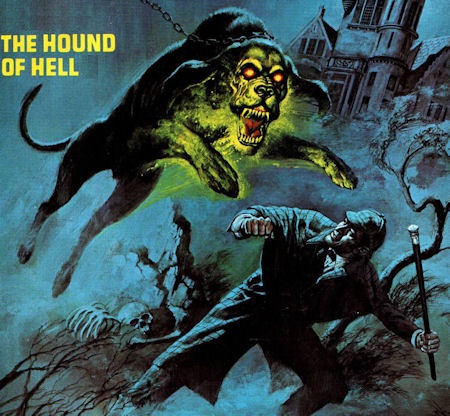 (Marvel Preview#6) - When Dr. Mortimer and Sir Henry left Baker
Street, Holmes hastened Watson to grab his hat and cloak so they could
follow them. Shadowing his new clients, Holmes soon spotted what he had
anticipated: Sir Henry had another surveilling him, a heavily-bearded
man in a hansom cab. Realizing he had been spotted, the passenger had
his cabman race away before he could be approached. With no reason to
continue following Sir Henry, Holmes instead sent a wire to identify the
cabman and enlisted a youth, Cartwright, to check the lobbies of hotels
round Charing Cross for the tell-tale newspaper.
(Marvel Preview#6) - When Dr. Mortimer and Sir Henry left Baker
Street, Holmes hastened Watson to grab his hat and cloak so they could
follow them. Shadowing his new clients, Holmes soon spotted what he had
anticipated: Sir Henry had another surveilling him, a heavily-bearded
man in a hansom cab. Realizing he had been spotted, the passenger had
his cabman race away before he could be approached. With no reason to
continue following Sir Henry, Holmes instead sent a wire to identify the
cabman and enlisted a youth, Cartwright, to check the lobbies of hotels
round Charing Cross for the tell-tale newspaper.
Later that day, Holmes and Watson visited the Northumberland to find Sir Henry raging, shouting that the hotel was full of thieves because two of his boots had disappeared, first a brand new one, and later an old one. Informed about the man who had been following Sir Henry, Mortimer could only recall one bearded man matching the description, Sir Charles' butler, Barrymore; though Holmes believed the hansom passenger's beard to be false, he checked Barrymore's whereabouts, and confirmed the butler had been hundreds of miles away in Baskerville Hall at the time. Tracking down the cab driver likewise proved a waste of effort, as the passenger had audaciously identified himself as Sherlock Holmes, and the search for the hotel where the newspaper had been cut up yielded no results. With all three of his initial threads snapped, and his quarry aware that the detective had been brought into the case, Holmes elected to use subterfuge.
Seeking to regain the advantage of surprise, Holmes pretended to be unable to leave London yet, he insisted that Watson instead accompany Sir Henry to Baskerville Hall, to observe and report back by telegram, and to protect their client. Once they had departed, Holmes followed to Dartmoor, and took up residence secretly in a stone hut upon the moors, undertaking his investigation covertly while receiving Watson's forwarded reports. Watson encountered Sir Henry's new neighbors, the siblings Jack and Beryl Stapleton, discovered that Barrymore and his wife were aiding the wife's escaped convict brother Selden who was hiding out on the moors, and learned that Sir Charles had been lured out of the safety of Baskerville Hall the night of his death on the pretext of meeting local woman Laura Lyons. Using information in Watson's reports that the good doctor had not realized were vital clues, Holmes discovered that Jack Stapleton was an alias, that he was secretly intimate with Laura Lyons, and that Beryl was Jack's wife rather than sister, the one responsible for sending the letter, desperately trying to warn Sir Henry without betraying her husband.
Meanwhile Watson spotted a distant figure atop a hill watching events, silhouetted by the moon. Believing it to be the convict Selden, that night Watson went to a stone hut where the man appeared to be staying, thus so discovering Holmes' deception. Greeting his friend warmly, Holmes explained his findings, but their reunion was interrupted by a terrible scream that cut through the night. Racing across the moors in the direction of the sound, they saw silhouettes of a man being pursued by a gigantic hound. but were too far away to stop the hound pouncing on its unfortunate prey. Cursing himself for not dealing with Stapleton the moment he realized the man's villainy, Holmes rushed to where the pursued man had fallen, finding what appeared to be Sir Henry lying in a pool of blood with a crushed skull, and no sign of the creature that had attacked him. Fearing that there was no evidence to connect Stapleton to the murder, Holmes turned the body over to discover the corpse was Selden, dressed in old clothes belonging to Sir Henry that had been provided him by his sister, Mrs. Barrymore. Seconds later, Stapleton himself arrived, claiming to be investigating the schemes. Hiding his hand, Holmes told Stapleton that the victim was not Sir Henry, but also claimed he had decided there was no case to investigate, so he and Watson would be returning to London the next day.
Holmes returned to Baskerville Hall with Watson, where the last pieces of the puzzle began to fall into place when he noted that if Stapleton were to grow a beard he would be the spitting of a portrait of Sir Hugo Baskerville. Concluding that Stapleton was himself a Baskerville, perhaps the son of Sir Charles' supposedly childless youngest brother, provided them Stapleton's motive for eliminating the other Baskerville heirs. Seeking to lure Stapleton into providing the proof needed to arrest him, Holmes kept his findings from Sir Henry and instructed him to take up Stapleton's standing dinner invitation that night and to walk home alone across the moors; despite expressing that this sounded insane, Sir Henry put his trust in Holmes and agreed. Having sent a telegram asking Inspector Lestrade of Scotland Yard to come from London with an arrest warrant, Holmes and Watson then made a show of going to the local train station, supposedly to catch the train back to London, but instead sent Holmes' young helper, Cartwright, with instructions to send a telegram in Holmes' name to Sir Henry once he reached Baker Street, to help sell the ruse.
Holmes and Watson then visited Laura Lyons, who upon learning that Stapleton was married confirmed that the villain had tricked her into luring Sir Charles out of the safety of Baskerville Hall the night he had died, and that she was willing to testify to the same. Next meeting Lestrade at the train station, the trio took a wagon to Stapleton's home, Merripit House. On the way Holmes explained to his fellows that Stapleton had stolen Sir Henry's boots in London so that the hound he had trained to play the role of the legendary fiend could get Sir Henry's scent; realizing he had first stolen a brand new boot that was useless for this purpose had been why a second boot had then been stolen, and it was Sir Henry's scent on his old clothes that had led the hound to attack Selden. The group covertly watched the house until Sir Henry left, then followed him; all too soon, a ghastly giant hound, glowing in the darkness, came into sight racing towards its victim. Rushing to Sir Henry's aid, Holmes shot his pistol but missed his target, and as the hound made its final leap at its prey, Holmes bodily tackled it. Man and beast grappled for a few seconds, with Holmes struggling to keep the massive snapping jaws from his throat, but then Holmes managed to roll backwards and send the hound flying with a kick. Before it could come at him again, the detective emptied five rounds into the beast, slaying it. Confirming it was merely a normal, albeit extremely large and savage, dog coated in phosphorescent, Holmes and his friends ran to Merripit to confront Stapleton, but found only Beryl, tied up and whipped by her husband for having tried to warn Sir Henry. Whole Holmes released her, she informed him that Stapleton had gone to the abandoned mine by nearby Grimpen Mire, where he normally kept the hound shackled during the day. Spotting Holmes approaching, Stapleton attempted to flee, but in the darkness he ran straight into the mire and was sucked down into the boggy ground. Holmes called to the man to reach out and take his hand, but the bitter Stapleton threatened to pull Holmes in too if he tried to rescue him, and moments later sank below the surface to his death. After accepting Sir Henry and Beryl's thanks, and he and Watson set off back to London, with Holmes informing his friend and colleague that they had never hunted so dangerous a man as the one now lying beneath the mire.
(The Sussex Vampire short story (fb) - BTS) - In Watson's absence, Holmes solved the case of the ship Matilda Briggs for the solicitors Morrison, Morrison and Dodd, a case which was associated with the giant rat of Sumatra, a story he felt the world was not prepared for (see comments).
(Marvel Preview#6, illustration) - On a crowded London street, Holmes was shot at by a man leaning out of a racing hansom cab (see comments).
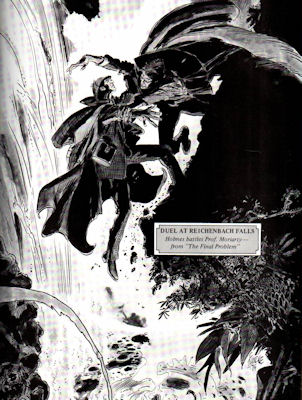 (Gathering of the Sinister Six novel) - Professor James
Moriarty, the "Napoleon of Crime," founded the Machiavelli Club, whose
members included the worst rogues in history.
(Gathering of the Sinister Six novel) - Professor James
Moriarty, the "Napoleon of Crime," founded the Machiavelli Club, whose
members included the worst rogues in history.
(Marvel Westerns: Outlaw Files) - Visiting the United
States of America and the "Wild West," Sherlock encountered the
gunslinger Rawhide Kid, who assisted him in a case involving "giant
glowing bears" in a "valley of doom" (see comments).
(Marvel Preview#5, illustration - BTS) - In 1891 Holmes exposed Moriarty's network of criminality, and by the close of April, thanks to Holmes' machinations, the police's net was closing on Moriarty's entire gang. However, Moriarty made it clear he would have his revenge, so Holmes and Watson slipped away to continental Europe hoping to stay out of Moriarty's reach until matters were concluded. Unfortunately, Moriarty evaded the police's net and pursued Holmes, and on 5th May 1891 he lured Watson away with a false medical emergency and cornered his prey atop the Reichenbach Falls in Switzerland.
(Marvel Preview#5, illustration) - Holmes and Moriarty grappled at the edge of the terrible falls.
(Marvel Preview#5, illustration - BTS) - Using his expertise in the obscure martial art Baritsu, Holmes threw Moriarty off the cliffs to his death. However, a sniper then shot at him, confirming his concern that Moriarty's lieutenant, Sebastian Moran, had accompanied his master and was now seeking revenge. Holmes escaped and went into hiding, letting Watson and the world believe he was dead.
(short stories) - Eventually Holmes returned in 1894
when the opportunity provided itself to capture Moran, and was reunited
with his friend.
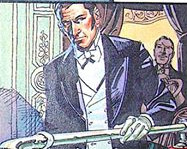 (The
New Adventures of Sherlock Holmes) - In September 1901 (see
comments) Holmes and Watson attended a London performance of
Watson's new play based loosely on his adventures. However, Holmes grew
annoyed at the play's exaggerated portrayal, and when it went so far as
to depict him in deerstalker and cape while he and his adversary swung
from ropes off the top of Nelson's Column to sword fight in mid-air,
Holmes' temper got the best of him. After loudly decrying the play's
shortcomings from his theater box, Holmes stormed out. An apologetic
Watson followed him to the street, and the pair began walking home,
becoming separated by a few paces as Watson stopped to buy the latest
copy of The Strand while Holmes continued on, seemingly oblivious to
Watson's sudden absence from his side, or the newspaper seller suddenly
accosting Watson with a knife...
(The
New Adventures of Sherlock Holmes) - In September 1901 (see
comments) Holmes and Watson attended a London performance of
Watson's new play based loosely on his adventures. However, Holmes grew
annoyed at the play's exaggerated portrayal, and when it went so far as
to depict him in deerstalker and cape while he and his adversary swung
from ropes off the top of Nelson's Column to sword fight in mid-air,
Holmes' temper got the best of him. After loudly decrying the play's
shortcomings from his theater box, Holmes stormed out. An apologetic
Watson followed him to the street, and the pair began walking home,
becoming separated by a few paces as Watson stopped to buy the latest
copy of The Strand while Holmes continued on, seemingly oblivious to
Watson's sudden absence from his side, or the newspaper seller suddenly
accosting Watson with a knife...
(short stories) - Holmes eventually retired in late 1903 or early 1904 and moved to a farm on the South Downs, Sussex, where he took up beekeeping. Just before the First World War he came out of retirement for his last known case, helping to capture a Prussian spy, Von Bork.
(Giant Size-Master of Kung-Fu#3 - BTS) - Sherlock had a niece, apparently highly intelligent like her uncle (it is unconfirmed whether she was the daughter of Mycroft, or whether Sherlock and Mycroft had another sibling whom Holmes failed to mention to his chronicler, Dr. Watson - see comments). Holmes' niece had a son, Clive Reston, via a liaison with James Bond. Clive either met his great-uncle or heard so many stories about him that Clive felt he knew Holmes; he described his great-uncle as being considerably more intellectual than his father, and exceptionally fond of playing the violin, often playing through all hours of the night because he felt it helped him think.
(All-New Official Handbook of the Marvel Universe Update#2, Clive Reston entry) - Reston inherited both a talent for deductive reasoning and a habit of smoking a meerschaum pipe from his great-uncle (see comments).
(Before the Fantastic Four: Reed Richards#1 (fb) - BTS) - While globetrotting in their youth, Reed Richards and Alyssa Moy encountered the giant rat of Sumatra.
(Dr. Strange, Master of the Mystic Arts: Nightmare! novel) - The dream lord Nightmare trapped Clea in a realm where Sherlock Holmes and the Shadow flew biplanes against King Kong.
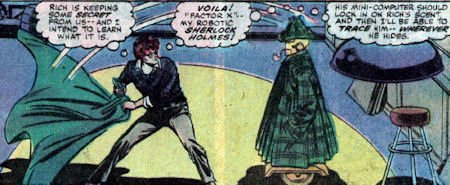 (Nova I#20 - BTS) - Robert Rider designed a robot, Factor X,
a.k.a. Sherly, patterned after Sherlock Holmes, to help him figure out
his brother, Richard's, secret.
(Nova I#20 - BTS) - Robert Rider designed a robot, Factor X,
a.k.a. Sherly, patterned after Sherlock Holmes, to help him figure out
his brother, Richard's, secret.
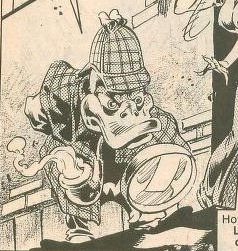 (Crazy Magazine#72) - Howard the Duck dressed up as
Sherlock Holmes while hunting for the key to the men's room.
(Crazy Magazine#72) - Howard the Duck dressed up as
Sherlock Holmes while hunting for the key to the men's room.
(Defenders I#150) - The Beast set up a holosystem game in the Defenders' headquarters, "When Titans Clash," with players having to evade hologram antagonists based on real-life heroes including Nick Fury, Dr. Strange, the X-Men, Fantastic Four, Ghost Rider, Werewolf by Night, Hulk, Thor, Captain America, and Sherlock Holmes and Dr. Watson (see comments).
Comments: Created by Sir Arthur Conan Doyle.
Adapted to Marvel comics by Doug Moench and Val
Mayerik.
As I suspect virtually anyone reading this already knows, Sherlock Holmes is unquestionably the most famous fictional detective in the world. He's not the first: Edgar Allen Poe's C. Auguste Dupin is usually considered to hold that title, and Conan Doyle acknowledged Dupin's influence on his creation, as well as that of French author Émile Gaboriau's detective Monsieur Lecoq, to the extent that both are even referenced by the characters in Holmes' first story, A Study in Scarlet (though unlike Conan Doyle, who was complimentary about his forebears' influence on the genre, the somewhat arrogant Holmes derides both of his counterparts as lacking in deductive skills). Conan Doyle wrote 62 stories involving Holmes, the "canon," but there are literally hundreds, if not thousands, of novels and stories written by other authors. He's been used in more unofficial novels that any other literary character, not only "mundane" mysteries but also taking on esoteric opponents from other fiction including Dr. Jekyll/Mr Hyde, H.G.Well's Martians, Dracula, Raffles, the Invisible Man, Jack the Ripper, French master villain Arséne Lupin, Fu Manchu, Frankenstein's Monster, the Phantom of the Opera, and Great Cthulhu himself, and teamed up with the likes of the Doctor; the very first unofficial Holmes story (My Evening With Sherlock Holmes) was written by Doyle's close friend J.M. Barrie, better known for Peter Pan, in 1891, only four months after the first Holmes story was published. We've had Holmes as a boy detective, and as an elderly man, plus everyone in his supporting cast has had their own spin-off stories, usually revealing that they too were world-class detectives. And I really do mean everyone - his brother Mycroft, his nemesis Moriarty, Moriarty's lieutenant Sebastian Moran, housekeeper Mrs. Hudson, female antagonist Irene Adler (Destiny's namesake), the various Scotland Yard detectives he worked with in one or other stories, Doctor Watson, Watson's first wife Mary Morstan, the street urchin information network dubbed the Baker Street Irregulars and their leader Wiggins, not to mention the spin-offs featuring new characters later authors added to the mythos: August Derleth's copycat detective Solar Pons (who might be his nephew Siger Holmes), the wife Sherlock never had Mary Russell, the other brothers we never heard about Sherrinford and Sigerson Holmes, the sisters we never got told about Enola and Eurus Holmes, the sons nobody mentioned Raffles Holmes and Auguste Lupa, even the mouse living in the cellars of 221B Baker Street - seriously! Basil of Baker Street, I kid you not!
And those are just the prose tales. Holmes is estimated to be the most prolific screen character in the history of cinema, starting way back in 1900 and continuing right into the modern day, where he's recently been played by Iron Man, Magneto and Dr. Strange. Then there are numerous comics, most notably (outside of his Marvel appearances) in D.C. where he's met Batman, John Constantine, Eclipso and Justice League Europe; Quality Comics where he encountered Kid Eternity; Fawcett alongside Captain Marvel Jr.; Warren Magazines helping the Rook; Rebellion's 2000A.D. as the true identity of the fantastical crimelord Stickleback; Victorian Undead during a zombie apocalypse; Wildstorm's Planetary where he was a member of a conspiracy that included Dracula and Frankenstein's Monster; Moonstone Comics for a team-up across time with night stalking reporter Carl Kolchak; and Dynamite's Prophecy for a case that also involved Vampirella, Ash Williams, Kulan Gath and Red Sonja. He's also a peripheral character in The League of Extraordinary Gentlemen. So the surprise isn't that he appeared in Marvel titles, but that he's appeared in so few of them.
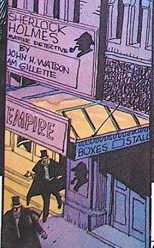 It turns out the Holmes nearly starred in brand new tales for Marvel UK
intended for 1994 publication in "The New Adventures
of Sherlock Holmes." Written by Tim Quinn and
drawn by John M. Burns, the series was partially illustrated when it, as
with so many other new Marvel UK series of the time, was cancelled due
to the Marvel UK implosion. Tim has since shared online the first page,
fully drawn, inked and colored, but not yet lettered. I've placed this
story in 1901, because the play Holmes storms out from is shown to be
co-written by "am Gillette"; in real life, actor William Gillette
adapted four of Sir Arthur Conan Doyle's Sherlock Holmes stories into a
play, and its London debut was in September 1901. And, indeed, Gillette
took some extreme liberties with Holmes' depiction, albeit with Doyle's
explicit permission. So in a world where Holmes was real and Watson the
author recounting his cases, and so jointly credited for the play, it
seems likely Holmes and Watson would attend the premiere performance,
and yes, Holmes, known not to appreciate how Watson portrayed him in
print, would be even less enamored of the further exaggerated theatrical
depiction.
It turns out the Holmes nearly starred in brand new tales for Marvel UK
intended for 1994 publication in "The New Adventures
of Sherlock Holmes." Written by Tim Quinn and
drawn by John M. Burns, the series was partially illustrated when it, as
with so many other new Marvel UK series of the time, was cancelled due
to the Marvel UK implosion. Tim has since shared online the first page,
fully drawn, inked and colored, but not yet lettered. I've placed this
story in 1901, because the play Holmes storms out from is shown to be
co-written by "am Gillette"; in real life, actor William Gillette
adapted four of Sir Arthur Conan Doyle's Sherlock Holmes stories into a
play, and its London debut was in September 1901. And, indeed, Gillette
took some extreme liberties with Holmes' depiction, albeit with Doyle's
explicit permission. So in a world where Holmes was real and Watson the
author recounting his cases, and so jointly credited for the play, it
seems likely Holmes and Watson would attend the premiere performance,
and yes, Holmes, known not to appreciate how Watson portrayed him in
print, would be even less enamored of the further exaggerated theatrical
depiction.
It’s also worth mentioning Malibu Comics, who published several Sherlock Holmes series under their Eternity and Adventure Comics imprint, since Marvel went on to buy Malibu, albeit after Malibu had finished with their Sherlockian titles. Notable among their releases were a four issue miniseries, Scarlet By Gaslight, that pitted Holmes against Dracula; Sherlock Holmes in the Case of the Missing Martian pitting Holmes against a War of the Worlds’ Martian; A Case of Blind Fear that saw Holmes take on H.G.Well’s Invisible Man; Sherlock Holmes: Return of the Devil wherein Holmes battled Satan; and a 23 issue series just titled Sherlock Holmes which reprinted a New York Herald-Tribune’s Sherlock Holmes newspaper strip featuring both adaptations of Conan Doyle stories and new mysteries.
We know Holmes exists as a real individual in Reality-616 (the mainstream Marvel universe); he's referenced clearly, albeit not named, by his great-nephew Clive Reston, the Marvel Atlas confirms him to be one of Britain's most prominent past citizens, and the novels The Gathering of the Sinister Six and Revenge of the Sinister Six reveal that 616's Machiavelli Club was founded by Holmes' nemesis Professor Moriarty. Naysayers would probably argue that Holmes and Watson being part of the Beast's hologame isn't proof of them being "real," and while that's true, every single other person in the game is, so why not them too? Likewise, the reference to the giant rat of Sumatra in Before the FF: Reed Richards#1 doesn't mention Holmes himself, but I still consider it circumstantial evidence of the adventure Holmes once mentioned. For the profile above, I'm running with the ASSumption that the sole complete story Marvel adapted, The Hound of the Baskervilles, features Earth-616 Holmes, because otherwise the entire entry would only be passing references to the man, which doesn't make for much of a read on its own.
The obvious
appearances I have left off are the ones of Holmes taking on Deadpool in
Deadpool Killustrated, because that's definitely an alternate reality
Holmes - the series refers to his reality as part of the Ideaverse, but
that is simply splitting hairs over what to call different sections
of the Omniverse. That Holmes will get an Appendix entry eventually, but
his being in that story and hence confirmed to be a known fictional
character on 616 doesn't rule him out as also being real in 616;
Dracula, Captain Nemo and the Frankenstein Monster all appear in
Killustrated too, and we've seen their 616 versions, plus we know that
everyone from Spider-Man to Kid Colt have fictional tales published
about them in 616, while in our reality genuine historical figures are
used as a basis for fictional characters all the time.
As with profiles I've done for other characters brought into the Marvel universe (cf. Raffles, the Doctor, Popeye, etc.), for the most part I'm only acknowledging allies, enemies and adventures explicitly shown to count for the 616 version, with an overview of the other tales featuring the character to provide a general understanding of their life. These other tales might also be true for the 616 version, but we can't know for sure. I've ASSumed he was a foe of the Machiavelli Club, despite there being no stories which depict this; it was founded by his foe Moriarty, and Holmes and Moriarty's criminal network considered one another something to be destroyed, so I have no doubt that he and the Machiavelli Club would likewise be mortal enemies; I've only listed Club members who would have been around at the same time Holmes was known to be alive though.
Reston's mother might be the daughter of Sherlock's known brother, Mycroft, but he's had additional siblings revealed in other post-Conan Doyle tales, so there's no reason that can't be true in Marvel too; if Sherlock came across as uninterested in romantic liaisons (with either gender) in the original tales, Mycroft was doubly so.
The illustration of Holmes being shot at in Marvel Preview#6 doesn't obviously come from any canonical Holmes tale I can recall. It might be meant to be a scene from The Final Problem, the story where Moriarty tries to kill Holmes, but the scene in that tale involves a hansom cab trying to run Holmes down, not someone trying to shoot him from one. Hence I'm treating it as a previously unknown adventure, unless someone can correct me and point out a canon story it relates to.
While discussing illustration, it's worth mentioning that unlike the Marvel Preview version of Sherlock, the novel version never, ever smoked a curved calabash/meerschaum pipe - that comes from the first stage interpretation of Sherlock Holmes, whose actor, William Gillette, found it easier to speak with one of those pipes in his mouth than with any other type of pipe. He also rarely wore a deerstalker hat or Inverness cape; they are never mentioned in any canon stories, but are seen in a single Sidney Paget illustration, used for The Strand magazine's printing of The Boscombe Valley Mystery. Marvel's adaptation has him wearing them both any time he's out of doors, but wearing a deerstalker and inverness cape in town during the Victorian era would be like walking around a modern city in lederhosen and a Fez; both are fine in the appropriate settings, but wear them anywhere else, and people will be sniggering behind your back.
It's mostly guesswork as to where Holmes' story involving the giant rat of Sumatra goes; it's referenced in a story that took place shortly after Holmes returned from the dead, and occurred when Watson wasn't present, but this could mean it took place in Holmes' early days before he met Watson, or when Watson was absent for other reasons - Watson married Mary Morstan in 1889, and so moved out of Baker Street, resulting in him only occasionally accompanying Holmes thereafter. Mary died in the years that Holmes was believed dead, so upon Holmes' reappearance, Watson returned to Baker Street and was again regularly in Holmes' company. Since Holmes mentions the Matilda Briggs case to Watson because he gets a letter from the client he helped in that case, I've ASSumed the case took place relatively recently rather than over a decade ago, placing it in the period that Watson was married. If anyone reading this is aware of other references to Holmes as a real character in 616 that I've overlooked, please do drop us a line.
Sherlock encountered the Rawhide Kid? When
did this happen, you might reasonably ask? To be honest, we don't
actually know that it did, but Marvel Westerns: Outlaw Files, presented
as a collection of in-universe documents, mentions several movies made
within the Marvel universe (Earth-616) about the Rawhide Kid. A number
of these can be matched to actual comic stories - or, in context, actual
events that happened to 616 Rawhide Kid. And one of the movies was "The
Valley of Doom (1958) - RK meets Sherlock Holmes and gives him a run for
his money in the detective department in a case about giant glowing
bears." So I'm running with the ASSumption that this movie is based on a
"real" encounter that actually happened within 616. The next speculation
is then in what year it might have happened. Rawhide Kid's career
spanned from 1868 to at least 1897; Holmes was active as a detective
from 1878 to at least 1914 (his last canonical case took place shortly
before the outbreak of the First World War). So assuming we aren't
dealing with either a boy adventurer Sherlock running into Rawhide in
the early 1870s (though Sherlock still being a precocious teen not yet
at the height of his perceptive powers might explain how the gunslinger
could give him "a run for his money" as a detective), nor a pair of
elderly adventurers in the twilight of their years, we're likely looking
at between 1878 to 1897. It's also unlikely, though not impossible, to
have taken place during the time Holmes was playing dead, and frankly if
you are going to have Holmes meeting an iconic gunslinger, you'd want it
to take place during the height of the "Old West," so probably before
1890. You'd also think that if Holmes had already encountered monstrous
glowing beasts, it would be the kind of anecdote you'd mention the next
time you encounter something similar; since Holmes never mentions
glowing bears during the case of the Hound of the Baskervilles, I'd like
to believe the Hound case came first. Finally, since there's also no
mention of Watson in that movie synopsis, I have decided to place Holmes
visit to the States and encounter with Rawhide Kid during the period
that Watson was married and only occasionally joining Holmes on his
cases.
An amusing (well, I find it amusing, ymmv) anecdote regarding Holmes' knowledge of Baritsu. When DC held the rights to publish both Doc Savage and the Shadow, they engineered a crossover adventure between the pair. Very different breeds of crimefighter, the two Pulp heroes initially fought one another, until one grabbed the other in a Baritsu hold, only for the other to break free with the appropriate Baritsu countermove. This immediately halted the fight, as each realized that there was only one man in the world who could have taught either of them this skill, and each trusted that man to be a good judge of character. As a teen reading this, I immediately realized this was a subtle reference to them both training under Sherlock Holmes, a nice Easter egg. I didn't realize how subtle until a few years later when I met one of the editors of those comics at a convention and informed him how much I had appreciated the reference. The editor then admitted that while he remembered the characters' comment about sharing a trusted teacher, he'd hadn't realized it applied to an actual established character, let alone Sherlock Holmes, until I had told him - the writer had slipped it passed him too.
Profile by Loki.
CLARIFICATIONS:
Sherlock Holmes has no known connections to
Dr. John Watson has no known connections to
The Hound(s) of the Baskervilles have no known connections to
Sir Henry, Sir Hugo and Sir Charles Baskerville have no known connections to
Dr. Mortimer has no known connections to
Jack and Beryl Stapleton have no known connections to
Mr. and Mrs. Barrymore have no known connections to
Selden has no known connections to
Laura Lyons has no known connections to
Mr. Frankland has no known connections to
Cartwright has no known connections to
Inspector Lestrade has no known connections to
Professor Moriarty has no known connections to
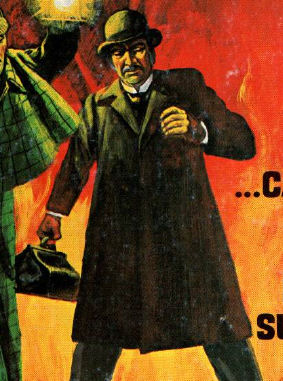 (novels and short stories) - John H. Watson was Sherlock
Holmes' friend and biographer. He had qualified as a Doctor of Medicine
from the University of London in 1878, then became a surgeon in the
British Army, and was serving in India attached to the Fifth
Northumberland Fusiliers when the Second Afghan War broke
out. Accompanying them to Kandahar Province in Afghanistan, he was
shot in the shoulder during the Battle of Maiwand and subsequently
invalided out the army. Returning to London, he stayed for a while in a
hotel on the Strand, but with his dwindling finances, he soon realized
he either had to leave the city for the countryside or find somewhere
cheaper to live. A chance encounter with a colleague from medical
school, Stamford, led to his meeting Sherlock Holmes and sharing
lodgings with the detective at 221B Baker Street. Watson was ever the
faithful and reliable companion, never equal in comparison to his
friend's towering intellect, but no buffoon and capable with both fists
and a pistol when required. Despite years of exposure to his friend's
ability to deduce facts from the tiniest of clues, he never lost his
sense of wonder when Holmes demonstrated this ability; Watson himself
became more observant over time, frequently able to spot significant
clues, but not to correctly interpret them as Holmes could.
(novels and short stories) - John H. Watson was Sherlock
Holmes' friend and biographer. He had qualified as a Doctor of Medicine
from the University of London in 1878, then became a surgeon in the
British Army, and was serving in India attached to the Fifth
Northumberland Fusiliers when the Second Afghan War broke
out. Accompanying them to Kandahar Province in Afghanistan, he was
shot in the shoulder during the Battle of Maiwand and subsequently
invalided out the army. Returning to London, he stayed for a while in a
hotel on the Strand, but with his dwindling finances, he soon realized
he either had to leave the city for the countryside or find somewhere
cheaper to live. A chance encounter with a colleague from medical
school, Stamford, led to his meeting Sherlock Holmes and sharing
lodgings with the detective at 221B Baker Street. Watson was ever the
faithful and reliable companion, never equal in comparison to his
friend's towering intellect, but no buffoon and capable with both fists
and a pistol when required. Despite years of exposure to his friend's
ability to deduce facts from the tiniest of clues, he never lost his
sense of wonder when Holmes demonstrated this ability; Watson himself
became more observant over time, frequently able to spot significant
clues, but not to correctly interpret them as Holmes could.
(Marvel Preview I#5) - As was frequently the case, Watson was present when a new client, Dr. Mortimer, brought a case for Holmes' attention. He listened to the country physician recount the macabre legend of the Hound of the Baskervilles and the outre circumstances of Sir Charles Baskerville's recent death, and later met Sir Henry Baskerville after Dr. Mortimer brought him to 221B.
(Marvel Preview I#6) - When Dr. Mortimer and Sir Henry left Baker Street, Watson accompanied Holmes as he shadowed the pair and this spotted a man following them. Wanting to lull the miscreant into a false sense of security, but needing a reliable person to provide intelligence and watch over Sir Henry, Holmes pretended to have pressing business that prevented him leaving the capital, asking Watson to go to Dartmoor in his stead and send telegrams reporting anything of interest. Soon after arriving in the area Watson learned that an escaped convict was on the loose when the carriage carrying him to Baskerville Hall was stopped by a soldier taking part in the hunt. Unable to sleep during his first night in the Hall, Watson heard a woman crying in the night, and when he questioned the butler Barrymore the next morning, it became clear the only person who might fit the bill was Barrymore's wife, despite Barrymore insisting the sound did not come from her. Watson was sharp enough to spot that Barrymore was lying, though his initial suspicion was spousal abuse. Aware that Barrymore had been ruled out as the man spotted tailing Sir Henry in London because he had only a few hours later responded to a telegram sent to Baskerville Hall, Watson checked with the local postmaster, whose delivery boy confirmed that he had only actually seen Mrs. Barrymore while delivering the test telegram.
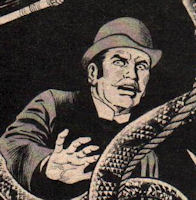 Walking back from Grimpen Village across the
moors, Watson encountered Jack Stapleton out butterfly hunting, who
warned him of the dangers of Grimpen Mire, pointing out a pony that had
become caught in the mire's clutches. When Stapleton left in pursuit of
a moth, Watson was approached by Beryl Stapleton, who cryptically but
urgently warned him to return to London. Seeing her "brother" returning,
he asked him not to mention her utterings, and was surprised when he let
slip Watson's name, revealing she thought she had been talking to Sir
Henry. Watson accepted an invitation to return with them to Merripit
House, where Stapleton asked him if he thought Sir Henry would mind them
visiting later that day, a request Watson noticed seemed to unsettle
Beryl again. Anxious to return to his charge who Watson had a sense was
in a vague, indefinable danger, the doctor agreed that the Stapletons'
visit should be fine, and made his excuses to leave. Walking across the
moor again, he was surprised to see Beryl waiting ahead of him, having
raced along a short cut to overtake him in order to apologize for her
earlier warning, insisting it did not apply to him. When Watson asked
what danger she had referred to, she insisted it was merely that she
believed the legend of the hell-hound.
Walking back from Grimpen Village across the
moors, Watson encountered Jack Stapleton out butterfly hunting, who
warned him of the dangers of Grimpen Mire, pointing out a pony that had
become caught in the mire's clutches. When Stapleton left in pursuit of
a moth, Watson was approached by Beryl Stapleton, who cryptically but
urgently warned him to return to London. Seeing her "brother" returning,
he asked him not to mention her utterings, and was surprised when he let
slip Watson's name, revealing she thought she had been talking to Sir
Henry. Watson accepted an invitation to return with them to Merripit
House, where Stapleton asked him if he thought Sir Henry would mind them
visiting later that day, a request Watson noticed seemed to unsettle
Beryl again. Anxious to return to his charge who Watson had a sense was
in a vague, indefinable danger, the doctor agreed that the Stapletons'
visit should be fine, and made his excuses to leave. Walking across the
moor again, he was surprised to see Beryl waiting ahead of him, having
raced along a short cut to overtake him in order to apologize for her
earlier warning, insisting it did not apply to him. When Watson asked
what danger she had referred to, she insisted it was merely that she
believed the legend of the hell-hound.
Watson found Dartmoor so remote from modern life that prehistoric stone huts still stood on the moor, and learned that the convict Selden was believed to have left the area, since he would have run out of food if still hiding out on the isolated moors. Later he accompanied Sir Henry as they visited the standing stones where Sir Hugo was said to have died centuries ago, and thence to Merripit House, where he noticed the instant attraction that arose between Sir Henry and Beryl Stapleton, and the intense disapprobation this engendered in Jack Stapleton. Still getting the lay of the land and locals, he visited Mr. Frankland at Lafter Hall, learning of his telescopic surveillance of the moors in hopes of spotting Selden. His suspicions about Barrymore remaining strong, when Watson heard stealthy footsteps passing his bedroom door at night, he snuck out to investigate, and witnessed a furtive Barrymore carry a lamp to a window overlooking the moor and stand staring out for several minutes. Sharing his discovery with Sir Henry, he discovered his host had noticed Barrymore's nighttime walks too, a seemingly regular event, and they agreed to shadow him that night and learn what he was up to. Sir Henry then insisted in going out alone, so Watson naturally followed him covertly, and witnessed Sir Henry meeting with Beryl; by their body language, Watson was sure Sir Henry was expressing his interest, while Beryl seemed willing, but held back for reasons unknown. Moments later Watson witnessed an angry Jack Stapleton arrive to drag his sister home, leaving Sir Henry confused and dejected. Approaching Sir Henry and admitting his spying, Watson was told that the lord had proposed to Beryl, and he was confused by Jack's unwillingness to let Beryl make her own decision in this matter, or her lack of protest at his interference.
That night Watson and Sir Henry together followed Barrymore as he visited the window, this time seeing him then leave the house, heading towards another light out on the moor. Determined to get to the root of the mystery, the two men went out too, but a strange and bloodcurdling howl rent the darkness, startling Sir Henry so that he knocked some stones loose, alerting Barrymore to their presence. Barrymore bolted, but the two men followed the other light to see where he was going, and caught a glimpse of Selden before the convict also fled. Watson considered shooting him, but could not bring himself to gun down an unarmed man who was fleeing, not even a known murderer. He and Sir Henry tried to pursue, but were stopped by the return of Barrymore, this time accompanied by his wife. She explained that she was Selden's sister, and had been helping him survive out of a sense of familial love and duty, an excuse Sir Henry accepted. As the group began to return to the Hall, Watson and Sir Henry spotted another figure silhouetted in the moonlight atop a tor, in the wrong direction to be Selden. The figure swiftly vanished, and with more eerie howling coming across the moors, Watson agreed with a shaken Sir Henry to forego another hunt.
The next day Barrymore, grateful to Sir Henry for promising not to tell the authorities about Selden on the promise he would leave the area soon without harming anyone, revealed the remains of a letter Sir Charles had tried to burn in the fireplace. The missive, signed only "L.L.", asked Sir Charles for a meeting at the time and location he had met his death. Barrymore confirmed that the only person he could think of whose initials matched the letter was Laura Lyons, so Watson visited her. She admitted sending the letter as she had hoped to procure Sir Charles' financial assistance and for propriety's sake could not be seen visiting a bachelor at his home, but that she had then received the aid she needed elsewhere, and so had failed to show. Certain she was withholding something but convinced he could learn no more for the moment, Watson set off back to Baskerville Hall, but en route his carriage passed by Lafter Hall, and he was flagged down by an excited Frankland, who informed Watson that he had uncovered Selden's hiding place by spotting someone delivering food to it. Thinking he would see Barrymore, Watson looked through Frankland's telescope, and instead saw a young boy carrying packages to one of the stone huts.
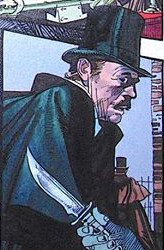 Watson ordered his driver, Perkins, to take him as close as he could to
the huts, then return to Baskerville Hall as fast as he could and remain
by Sir Henry's side. By the time Watson reached the hut, the boy had
departed, but it was clear that someone was living there from the
bedding and small amount of furniture. Then he discovered a note on a
small wooden table, and discovered to his shock that it related his
recent movements. The revelation that someone had been spying on him
barely had time to sink in before he heard a footstep outside the
hut...and Sherlock Holmes' voice wishing him a good evening. Holmes
explained to Watson his subterfuge, and that he had been the mysterious
figure spotted the previous night. He also informed Watson that he was
sure their villain was Stapleton, having discovered thanks to Watson's
information, that Beryl was Jack's wife, not his sister. Their
discussion was interrupted by a man's scream, which proved to be Selden
being attacked by the Hound. The two friends arrived too late to save
the convict, finding the body moments before Jack Stapleton arrived,
claiming to have also responded to the cry. Watson thereafter remained
by Holmes' side as he fooled Stapleton into believing they were both
leaving Sir Henry unguarded by returning to London, confronting Laura
Lyons to confirm how Stapleton had tricked her into luring Sir Charles
to his death, then intervening when Stapleton unleashed the Hound on Sir
Henry. After Stapleton drowned in the Grimpen Mire, Watson joined
Holmes in saying their farewells to Sir Henry and Beryl, and returning
to London.
Watson ordered his driver, Perkins, to take him as close as he could to
the huts, then return to Baskerville Hall as fast as he could and remain
by Sir Henry's side. By the time Watson reached the hut, the boy had
departed, but it was clear that someone was living there from the
bedding and small amount of furniture. Then he discovered a note on a
small wooden table, and discovered to his shock that it related his
recent movements. The revelation that someone had been spying on him
barely had time to sink in before he heard a footstep outside the
hut...and Sherlock Holmes' voice wishing him a good evening. Holmes
explained to Watson his subterfuge, and that he had been the mysterious
figure spotted the previous night. He also informed Watson that he was
sure their villain was Stapleton, having discovered thanks to Watson's
information, that Beryl was Jack's wife, not his sister. Their
discussion was interrupted by a man's scream, which proved to be Selden
being attacked by the Hound. The two friends arrived too late to save
the convict, finding the body moments before Jack Stapleton arrived,
claiming to have also responded to the cry. Watson thereafter remained
by Holmes' side as he fooled Stapleton into believing they were both
leaving Sir Henry unguarded by returning to London, confronting Laura
Lyons to confirm how Stapleton had tricked her into luring Sir Charles
to his death, then intervening when Stapleton unleashed the Hound on Sir
Henry. After Stapleton drowned in the Grimpen Mire, Watson joined
Holmes in saying their farewells to Sir Henry and Beryl, and returning
to London.
(short stories) - Watson later married Mary Morstan and moved out of Baker Street, only occasionally thereafter assisting in Holmes' cases, until Holmes was believed slain at the Reichenbach Falls by Professor Moriarty. Sometime during the next three years Mary died, so that by the time Holmes revealed he was still alive, Watson was again single, and he moved back in to Baker Street.
(The New Adventures of Sherlock Holmes) - In September 1901 (see comments) Holmes and Watson attended a London performance of Watson's new play based loosely on his adventures. However, Holmes grew annoyed at the play's exaggerated portrayal, and when it went so far as to depict him in deerstalker and cape while he and his adversary swung from ropes off the top of Nelson's Column to sword fight in mid-air, Holmes' temper got the best of him. After loudly decrying the play's shortcomings from his theater box, Holmes stormed out. An apologetic Watson followed him to the street, and the pair began walking home, becoming separated by a few paces as Watson stopped to buy the latest copy of The Strand while Holmes continued on, seemingly oblivious to Watson's sudden absence from his side, or the newspaper seller suddenly accosting Watson with a knife...
(short stories) - Watson remarried in 1903, around the same time Holmes officially retired. In August 1914, just before the outbreak of the Great War, he rejoined his old friend to assist in capturing the Prussian spy Von Bork, and when the conflict began he re-enlisted despite his advancing age, as part of the Royal Army Medical Corps.
--Marvel Preview I#5 (6, The New Adventures of Sherlock
Holmes (unpublished)
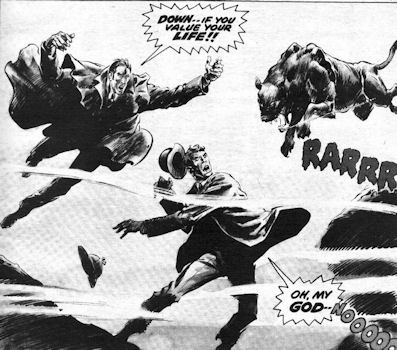 The Hound of the
Baskervilles (Victorian era)
The Hound of the
Baskervilles (Victorian era)
A bloodhound/mastiff crossbreed, Stapleton's Hound of the Baskervilles was a gigantic black canine trained to be ferocious and to track and attack anyone whose scent it had been given. Stapleton hid it chained up in an abandoned mineshaft on the moors, which sometimes helped its howls echo eerily across the moors without a discernible source. To build the legend, Stapleton would let the Hound loose at night to be seen in the distance, coating it with a phosphorescent substance (Holmes suspected a cunning preparation of Barium Sulphide with no odor to interfere with the creature's sense of smell). When he learned that Sir Charles Baskerville, increasingly believing the legend thanks to catching distant glimpses of the Hound, was planning to move to London, Stapleton had to act more precipitously, and lured Sir Charles out to the edge of the moor; the Hound was released to hunt its unfortunate victim, who fled in abject terror upon sighting the spectral apparition tearing down upon him. Before the Hound reached him, Sir Charles' weak heart gave out. Immediately losing interest in its now still prey, the Hound paced around roughly twenty yards from the corpse, leaving large footprints later discovered by Dr. Mortimer, then returned to Stapleton.
Stapleton subsequently let the Hound loose after giving it Sir Henry Baskerville's old shoes to scent, but it chased down the convict Selden instead, because he was wearing old clothes belonging to Sir Henry that still carried his scent. The culmination of the pursuit, silhouetted against the moon atop a rocky hill, was witnessed by Holmes and Watson, as the Hound pounced, knocking Selden from the peak, a fall that crushed the man's skull. By the time the two witnesses reached the body, the Hound had gone, recalled by Stapleton.
Having failed the last time, Stapleton tried again when Sir Henry was walking home across the moors following a dinner at Merripit House. Once more the Hound stalked its prey, but this time Holmes was there to intervene. Holmes shot at the running monster, but missed, and had no time to take aim again. As the hound leapt, so too did Holmes, bodily tackling the creature in mid-air. They grappled for a few seconds, Holmes desperately struggling to avoid the Hound's snapping jaws, then Holmes rolled onto his back and kicked the Hound flying. The Hound began to race towards him again, but Holmes emptied his revolver, firing five shots into its head and flanks, finally laying the Baskerville family ghost to rest.
--Marvel Preview I#5 (6
The Hound of the
Baskervilles (legend)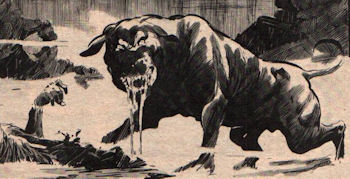
The legendary Hound of the Baskervilles appeared the night Sir Hugo Baskerville swore that evil could have his body and soul if only he could overtake a kidnapped girl who had escaped Baskerville Hall. It was witnessed pursuing Sir Hugo as he rode across the moors, and when he finally passed the point where the girl he had been chasing lay dead, evil's side of the bargain had been fulfilled. Sir Hugo fell from his horse, and the Hound ripped out his throat. Three of Sir Hugo's friends witnessed the killing, and fled in abject terror when the Hound turned its attention their way. One died that night from fear, while the other two were broken men for the rest of their days. From that night on, the Hell-Hound was said to plague the family, who warned each succeeding generation to never cross the moors at night.
--Marvel Preview I#5 (6
The son of Sir Charles Baskerville's younger brother, and the unknowing cousin of Jack Stapleton, Sir Henry Baskerville was wrongly believed to be the last of the family line. Having been farming in Canada when he inherited the family title, he returned to England, and was met when he arrived in London by Dr. Mortimer, who in turn introduced him to Sherlock Holmes and Dr. Watson. To his surprise, especially as he had only chosen where to stay after meeting Mortimer, Sir Henry had an anonymous letter (from Beryl Stapleton) left for him at his hotel, warning him to stay away from the moors.
He later completed his journey to Baskerville Hall with Dr. Watson as company and protection. When he met his neighbor Beryl Stapleton, the pair were instantly attracted to one another, and could not comprehend why her "brother" seemed determined to prevent them becoming closer. Holmes later instructed Sir Henry to accept an invitation to a dinner at Merripit House and to walk home alone across the moors, despite prior warnings never to do so; despite considering this madness, Sir Henry readily agreed, trusting the detective, who kept his theories about Jack Stapleton from Sir Henry to ensure he acted naturally and did not arouse the villain's suspicions. This led to Sir Henry being targeted by the Hound as he strolled back to Baskerville Hall, but Holmes killed the creature before it could harm Sir Henry. Following Jack Stapleton's demise, Beryl and Sir Henry apparently openly admitted their mutual affections, as they were together when Holmes and Watson made their farewells and returned to London.
--Marvel Preview I#5 (6
James Mortimer graduated medical school as an Member of the Royal College of Surgeons in 1882, and served as a house surgeon from 1882 to 1884 at Charing Cross Hospital in London, winning the Jackson Prize for Comparative Pathology. In 1884 he married and left Charing Cross Hospital to set up his own country practice in the parish of Grimpen on Dartmoor, Devon, and was gifted an engraved walking stick as a goodbye gift from his hospital colleagues. In his new home, he became good friends with his patient Sir Charles Baskerville.
In 1889, Sir Charles conveyed his fears about the Hound of the Baskerville to Mortimer, and after Sir Charles died, Mortimer discovered the corpse's face frozen in a rictus of terror as well as the footprints of the Hound near the body. Named Sir Charles' trustee and executor of his will, he grew fearful for Charles' heir, Henry, and coming to suspect there might genuinely be supernatural forces at work, he contacted Sherlock Holmes, recounting both the legend of the Hound of the Baskervilles and the mysterious circumstances of Sir Charles' demise. After Holmes agreed to take the case, Mortimer met the arriving Sir Henry at Waterloo Station, and brought him back to Baker Street. Following their meeting with the detective, Dr. Mortimer took Sir Charles back to Dartmoor, and kept occasional company with Sir Henry and Dr. Watson over subsequent days until the case was finally settled.
--Marvel Preview I#5 (6
"Jack Stapleton" was the son of family black sheep Rodger Baskerville, the younger brother of Sir Charles Baskerville and of Henry Baskerville's unidentified father. For a time he was a schoolmaster in the North of England, until an epidemic caused the death of some pupils, forcing the establishment to close, and eating up much of his capital (in this era, there were no public schools, so the schoolmaster owned the business). Jack then decided to inherit the family estate by dint of eliminating those ahead of him in the line of succession. Using his genuine interest as a naturalist with an yen for lepidoptery, he took up residence in Merripit House, making himself his uncle's neighbor. He soon learned his ways round the moors, in particular the often lethal Grimpen Mire, boggy ground that looked safe to the casual observer, but which actually had only a few safe paths, islands in a sea of grass-covered mud that regularly sucked any careless animal under. Obtaining a gigantic canine, he trained it to fill the role of the legendary Hound of the Baskervilles, keeping it chained up in an abandoned mine shaft during the day. Forcing his wife Beryl to pose as his sister, Jack wooed Laura Lyons so he could manipulate her into luring Sir Charles to the back of the Baskerville estate alone on the night of June 4th 1889, then unleashed his Hound, painted with phosphorescence to make it look spectral. This ruse successfully scared Sir Charles to death.
Learning that his next victim, his cousin Henry, was due to arrive in London from the Americas, Jack went to London to spy on him, intending to steal a personal item to provide the Hound with Henry's scent; not trusting his wife to be left alone back at Merripit, as she hated what he was doing but feared his anger, he took her with him. In London Stapleton disguised himself with a fake beard and tailed Sir Henry and Dr. Mortimer, but the cab he was in was spotted by Sherlock Holmes, forcing him to flee. Suspecting Holmes would track down the driver, Stapleton deliberately claimed to be Holmes to the cabbie.
Stapleton returned to Dartmoor to await Sir Henry's arrival, making a point of introducing himself and inviting him to dine at Merripit at some point, a pretext to lure his quarry out on to the moor at night. When he realized that Sir Henry was attracted to Beryl, Jack was jealous and sought to keep them apart. While making the acquaintance of Dr. Watson, he made the mistake of mentioning his past as a schoolmaster, which, combined with him being a naturalist, was enough information for Holmes to track down Stapleton's real name and learn that the Stapletons were married rather than siblings. Jack later let the Hound loose one night, thinking Sir Henry was abroad, but was disappointed to learn that the beast had slain the wrong target, having killed the convict Selden. He also learned at this time that Holmes had come to Dartmoor, but, still unaware the detective had been there for days and already suspected him, Stapleton believed Holmes had been genuinely fooled into dismissing the danger to Sir Henry as unwarranted. Tricked into thinking Holmes and Watson had returned to London, Stapleton arranged to host a dinner for Sir Henry, Mr. Frankland and Dr. Mortimer at Merripit House; learning Beryl no longer intended to keep her silence, Jack tied her up and whipped her, then left her hidden upstairs during the meal. After the meal, as his guests left to head home their separate ways, Jack raced to the mineshaft and released his Hound, but Holmes killed it before it could reach its intended prey. With Beryl's help, Holmes found Jack at the mine entrance, but the defiant murderer shot at them both, then attempted to flee across Grimpen Mire. Unable to discern the safe path in his haste and the darkness, he walked into boggy ground, and was trapped, slowly sinking beneath the surface. Holmes offered his hand to pull Jack out, but the maddened criminal threatened to pull him under too, swearing to kill the detective if it was the last thing he did. Moments later he vanished beneath the mud.
--Marvel Preview I#5 - BTS (6
The wife and unwilling accomplice of Jack Stapleton, Beryl hated what her husband was doing but feared his violent displeasure should she act against him. Nevertheless, when he took her to London so he could steal something from Sir Henry Baskerville to give his monstrous Hound the man's scent, she managed to slip briefly away and hurriedly wrote a brief warning letter to Henry. She and her husband subsequently returned to Dartmoor.
Having never actually seen Sir Henry, when
she first encountered Dr. Watson on the moors she mistakenly believed he
was the new baronet and tried to warn him to return to London, then told
him not to repeat what she had said as she spotted her "brother"
approaching them. Upon discovering Dr. Watson's actual identity, she
managed to slip away from Jack again briefly, just long enough to
retract her warning, and to insist she had only issued it in the first
place because she believed in the legend. When she finally met Sir
Henry, the pair shared an instant attraction, which aroused her
husband's jealousy, and eventually prompted her to try to warn Sir Henry
of Jack's true intentions.
Jack Stapleton arranged to host a
dinner for Sir Henry, Mr. Frankland and Dr. Mortimer at Merripit House,
but he discovered Beryl's plans to expose him, so he tied her up and
whipped her, then left her hidden upstairs during the meal. She was
released by Holmes after the Hound had been slain, and led him to the
mineshaft where her husband had been hiding the Hound. Jack shot at her
for this betrayal, but missed, and died moments later, drowning in
Grimpen Mire.
She and Sir Henry apparently then openly admitted their mutual affections, as they were together when Holmes and Watson made their farewells and returned to London.
--Marvel Preview I#5 - BTS (6
The Baskerville family line had fallen into financial decline until Sir Charles Baskerville inherited the family home and title. He had made his fortune in South Africa's diamond mining business, and in 1887 returned home to take up residence in Baskerville Hall. Despite his wealth, his own tastes were simple, and he retained few servants for the vast family home, most notably the Barrymores, with the husband serving as his butler and the wife as his housekeeper. A childless widower, he openly expressed the desire to ensure the whole countryside would profit from his good fortune, giving regularly and generously to charities. His amiability and extreme generosity won him widespread affection and respect, as he sponsored schemes of reconstruction and improvement in the region, to the point where many thought him a potential candidate to run for parliament in the next election, but Sir Charles' health began to decline as he developed a heart condition.
In 1889 Sir Charles began to take the legend of the Hound of the Baskervilles seriously, believing he was catching glimpses of it in the distance or hearing it baying in the night, unaware this was the very real dog with which his nephew Jack Stapleton intended to kill him. Scared, Sir Charles decided to relocate to London, at least temporarily, but on 4th June 1889, the evening of the day before his departure, Sir Charles was lured to the end of the Yew Alley at the back of the estate, to a gate that led onto the moor, on the pretext of meeting Laura Lyons. Instead, the poor man saw the Hound of the Baskervilles running across the moors towards him. He fled in terror, and his heart gave out before the beast reached him. His body was later discovered by Barrymore.
--Marvel Preview I#5 (6
Sir Hugo Baskerville held the manor
of Baskerville Hall around the time of the English Civil War
(1642-1651), and was well known as a wild, profane and godless man.
When his unwanted attentions where spurned by the daughter of a local yeoman, Sir Hugo and several of his friends kidnapped the girl when he knew her family were away over Michaelmas (the Feast of St. Michael, 29th September). They locked her in an upstairs room at Baskerville Hall while they caroused, but she escaped out a window, climbing down the ivy, and fled homeward across the moors, a distance of around nine miles. Soon thereafter the drunken Sir Hugo went upstairs, now ready to have his way with his captive, only to discover her absence. Enraged he rushed downstairs and swore to his companions that he would render his body and soul to the powers of evil that very night if he could but overtake the girl, inspiring one of his inebriated fellows to declare they should chase her down with their hounds. Hugo raced out, unleashed the dogs, and rode after them on his horse, and it was several minutes before his sozzled friends, now thirteen in number, marshalled their thoughts sufficiently to decide to follow him. As Sir Hugo rode across the moors following his dogs, he suddenly found he too was being pursued, in his case by a gigantic hound from Hell nearly as large as his horse. Though he tried to outrun it, eventually he fell from his steed just after he had finally caught up to the girl he had abducted, now lying dead by some standing stones, killed by fear and fatigue. Ten of Sir Hugo's friends had given up following upon seeing Sir Hugo's horse fleeing in terror, and his hounds milling around frightened, but three kept going. They reached the standing stones just in time to see the Hound of the Baskervilles rip out Sir Hugo's throat.
--Marvel Preview I#5 (6
Mr. and Mrs. Barrymore were Sir Charles Baskerville's main servants, serving as his butler and housekeeper respectively. Mr. Barrymore found Sir Charles' dead body and sent for Dr. Mortimer. After the inquest, Mr. Barrymore found the remains of Laura Lyons' letter to Sir Charles while cleaning out the fireplace; not believing it relevant to his death, and not wishing to cause gossip that might besmirch their late master's name, the couple decided initially not to tell anyone about their finding.
After Sir Charles' death, Mrs. Barrymore's convict brother, Selden, escaped prison, and approached her for help while he hid out on the moor. Though Mrs. Barrymore knew Selden had gone down an evil path, she could not help but remember him as the little boy she had cared for while growing up, so she felt duty bound to provide him with food, and enlisted her loving husband's aid to do so. Eventually they were caught in the act by Dr. Watson and Sir Henry, but upon hearing their reasons, their employer forgave them. Fearing his wife would die if her brother was imprisoned again, Barrymore elicited their promise not to inform the authorities of the convict's whereabouts on the promise that he would harm no one, and soon be on his way to South America. This kindness prompted Barrymore to share with Sir Henry and Dr. Watson the remains of the letter he had found, enabling Watson to track her down.
--Marvel Preview I#5 (6
Selden, the Notting Hill Murderer,
had committed his crime with such ferocity and wanton brutality that he
only escaped hanging because his crime had been so atrocious it led to
people doubting his sanity.
Sent to Princetown Prison, he escaped
onto nearby Dartmoor, knowing that his sister was nearby and he could
rely on her help, however reluctant.
At night he would exchange lantern
signals with his brother-in-law, arranging to pick up food and clothing
they provided, until one of the exchanges was interrupted by Dr. Watson
and Sir Henry.
Selden was later killed by the Hound of the Baskervilles, which attacked him because he was wearing some of Sir Henry's old clothing, and thus smelled of its target.
--Marvel Preview I#6
The daughter of Sir Henry's neighbor,
Mr. Frankland, Laura had married an artist named Lyons, who subsequently
deserted her, leaving her in dire financial straits. Disapproving of the
marriage in the first place, her father disowned her, but Sir Charles
helped her finance her setting up a typing service business, though his
retiring nature meant he only met her a couple of times and asked her to
keep his help a secret.
Jack Stapleton manipulated her,
entering into a covert romance by informing her he was married, and
offering her matrimony if she could secure a divorce. Since it was
difficult for a wife to get a divorce unless the husband agreed, and
Laura's was uncooperative, there would be expensive court proceedings
involved. Jack suggested she seek the financial help she would need for
the legal expenses from Sir Charles, but since he was intending to leave
for London, she would need to meet him urgently. Needing to avoid gossip
that might help her husband in the divorce proceedings, Laura could not
be seen to visit the home of a bachelor such as Sir Charles, so at
Jack's suggestion she sent a letter asking for a private meeting late at
night at the gate by the end of Baskerville Hall's Yew Alley, with an
instruction to burn the letter once read.
Once the letter was sent, Jack then appeared to change his mind, informing Laura that his self-respect would be hurt if he let another man help her, promising instead to spend his last penny winning her freedom. As a result, Laura failed to make her meeting, leaving Sir Charles alone to be hunted by the Hound. When she learned of Sir Charles' death, she considered speaking out at the inquest, but Jack scared her into silence, suggesting she might find herself implicated in Sir Charles' mysterious death.
Sir Charles had attempted to burn the letter as requested, but his butler Barrymore subsequently found a legible piece while cleaning the fireplace, which he later handed on to Dr. Watson. Though only signed with her initials, it was enough for Watson to track her down. Though Laura admitted to sending the letter, she kept Jack's name out of her explanation. However, when Watson returned in the company of Sherlock Holmes, the latter informed Laura that Jack was married. Instantly realizing how fully she had been used, this time she told them the full story.
--Marvel Preview I#5 - BTS (6
One of the few inhabitants of
Dartmoor, Mr. Frankland lived in Lafter Hall, effectively making him one
of the Baskerville's closest neighbors.
The father of Laura Lyons, the elderly,
white-haired, red-faced and choleric Frankland had a passion for the law
and enjoyed entering into litigation, picking fights purely for the
pleasure of fighting.
An amateur astronomer with a powerful
telescope, when he learned of the escaped convict in the area, he began
spending his days sweeping the moors with the telescope, hoping to spot
where the man was hiding. Instead, he eventually spotted Cartwright
delivering food to one of the stone huts on the moors; believing he had
uncovered Selden's hiding place and seeing Watson's carriage passing,
Frankland informed the doctor of his discovery, prompting Watson to
visit the hut and thus find Holmes.
He later attended the dinner Jack Stapleton held at Merripit House.
Dr. Mortimer erroneously calls him Mr. Franklin in Marvel Preview I#5.
--Marvel Preview I#5 - BTS (6
Perkins was the groom at Baskerville
Hall, tasked with looking after the horses and driving the carriage
whenever the lord or his guests needed to go somewhere.
Barrymore sent him to fetch Dr.
Mortimer after finding Sir Charles' dead body, and he later picked up
Sir Henry, Dr. Mortimer and Dr. Watson when they came back from London.
When Watson went to investigate Laura
Lyons, he had Perkins drive him to the village she lived in, Coombe
Tracey, and Perkins was taking Watson back to Baskerville Hall when
Frankland flagged them down.
Upon learning from Frankland that someone suspicious was staying in the stone huts on the moor, Watson had Perkins take him as near as he could, then ordered the groom to return to the Hall and keep a watchful eye on Sir Henry.
--Marvel Preview I#6
Cartwright was a youth working as an assistant at a District Messengers Office in London whose employer owed Holmes a favor. Holmes was thus able to request Cartwright's assistance, sending him to check hotels close to Sir Henry Baskerville's for the newspaper that had been cut up to make the warning letter Henry had received. Cartwright dutifully did so, but found nothing.
When Holmes came to Dartmoor, he took up
residence in a stone hut on the moors because it was vital to his plans
that his presence would remain a secret from the locals. Accordingly, he
also brought along Cartwright, who stayed in the local village but was
charged with bringing Holmes provisions. Since Watson was sending Holmes
regular reports by telegram, Holmes had these redirected back to
Dartmoor's messengers office, with Cartwright again handling taking them
to Holmes' hideaway.
One of his food deliveries was spotted by the eagle-eyed Mr. Frankland via telescope. As the case approached its climax, Holmes used Cartwright once more to send a telegram asking Inspector Lestrade to come from London with an arrest warrant, and Cartwright then relayed Lestrade's affirmative response. Holmes then sent Cartwright back to London, with the instruction to send Sir Henry a telegram in Holmes' name once there, in order to sell the deception that Holmes had left Dartmoor.
--Marvel Preview I#6
Inspector Lestrade was considered by
Holmes to be the best of the "professionals" of Scotland Yard, though
this was faint praise since he considered most of Scotland Yard to be
utterly incompetent.
When Holmes believed he had nearly
enough evidence to prove Jack Stapleton's guilt, he sent a telegram to
Lestrade in London, who sent one in response confirming he was bringing
an unsigned arrest warrant.
He accompanied Holmes and Watson to
surveil Merripit House, and on Holmes' instructions remained with their
wagon while Holmes followed Sir Henry as the lord began walking home
across the moors.
However, he came running when he heard Holmes firing his pistol, arriving at the scene to find Holmes and Sir Henry both safe and standing over the corpse of the slain hound.
--Marvel Preview I#6
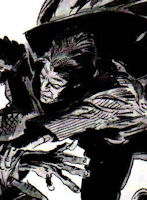 Dubbed the Napoleon of Crime by Holmes,
James Moriarty maintained a respectable front as a professor of
Mathematics at a small British university, while secretly being the
spider in the web of one of the most powerful syndicates of criminals in
Europe, an organization he ruled with a rod of iron; there was only one
punishment in his code, death! Holmes considered him "the greatest
schemer of all time, the organizer of every devilry, the controlling
brain of the underworld - a brain which might have made or marred the
destiny of nations" and "the organizer of half that was evil and of
nearly all that was undetected in London." He also founded the
Machiavelli Club, composed of criminals and rogues of a caliber similar
to his own.
Dubbed the Napoleon of Crime by Holmes,
James Moriarty maintained a respectable front as a professor of
Mathematics at a small British university, while secretly being the
spider in the web of one of the most powerful syndicates of criminals in
Europe, an organization he ruled with a rod of iron; there was only one
punishment in his code, death! Holmes considered him "the greatest
schemer of all time, the organizer of every devilry, the controlling
brain of the underworld - a brain which might have made or marred the
destiny of nations" and "the organizer of half that was evil and of
nearly all that was undetected in London." He also founded the
Machiavelli Club, composed of criminals and rogues of a caliber similar
to his own.
Despite Moriarty's genius and care at ensuring his own name remained unconnected to his syndicate's crimes, as Holmes' understanding of the criminal underworld grew, he became continually conscious of some power behind the malefactor, some deep organizing power standing in the way of the law and throwing its shield over the wrong-doer. Again and again across the widest variety of cases, he felt the presence of this force, and deduced its action in many undiscovered crimes where he had not been personally consulted. For years he sought to break through the veil which shrouded it, and at last the time came when he seized his thread and followed it, until it led him, after a thousand cunning windings, to ex-Professor Moriarty of mathematical celebrity. He found the Professor fenced round with safeguards so cunningly devised that it seemed impossible to get evidence which could convict in a court of law, eventually forcing Holmes to admit he had met an antagonist who was his intellectual equal, but finally he made a trip, only a little one, but with Holmes close on his trail, it was enough, enabling the detective to weave a net round him and his organization.
Just before it was ready to close,
Moriarty approached Holmes directly, warning Holmes to back off or be
killed. Holmes declined, and within minutes of leaving 221B Baker
Street, Moriarty's agents began attempting to assassinate the detective.
Holmes fled with Watson to Europe, aware that his arrangements meant
that the police should be able to deal with all of Moriarty's gang
within days, but Moriarty and his lieutenant, the sharpshooter Colonel
Sebastian Moran, escaped capture and followed them.
In Switzerland Moriarty caught up with his prey and confronted Holmes at the top of the Reichenbach Falls. The two men grappled, but while equally matched intellectually, Moriarty had only murderous rage in his favor, while Holmes was an expert martial artist, and he threw the crimelord over the falls to his death.
--Marvel Preview I#5 (Gathering of the Sinister Six
images: (without ads)
Marvel Preview I#5 cover (main)
Marvel Preview I#5, p3, pan 1 (headshot)
Beeton's Christmas Annual p23 (first ever illustration of Sherlock
Holmes and Dr. Watson by David Henry Friston)
Marvel Preview I#6 cover (the Hound leaps at Holmes)
Marvel Preview I#5 poster (Holmes battles Moriarty at the Reichenbach
Falls)
The New Adventures of Sherlock Holmes,
p1, pan 4 (Holmes at the theater)
Nova I#20, p3, pan5 (Sherly)
Crazy#72, p3 of Howard the Duck story, pan1 (Howard the Ducktective)
The New Adventures of
Sherlock Holmes, p1, pan5 (exterior of theater holding
Sherlock Holmes' play)
Marvel Preview I#5 cover (Watson main)
Marvel Preview I#5, p42, pan 1 (Watson headshot)
The New Adventures of
Sherlock Holmes, p1, pan8 (Watson, attacked by knifeman on
way home from theater)
Marvel Preview I#6 (the Hound of the Baskervilles attacks Sir
Henry)
Marvel Preview I#5, p23, pan 1 (the Hound of legend stands over Sir
Hugo's remains)
Marvel Preview I#5, p49, pan 2 (Sir Henry Baskerville)
Marvel Preview I#5, p9, pan 4 (Dr. Mortimer)
Marvel Preview I#6, p21, pan 1 (Jack Stapleton)
Marvel Preview I#6, p21, pan 4 (Beryl Stapleton)
Marvel Preview I#5, p47, pan 7 (Sir Charles Baskerville)
Marvel Preview I#5, p15, pan 3 (Sir Hugo Baskerville)
Marvel Preview I#6, p38, pan 5 (Mr. and Mrs. Barrymore)
Marvel Preview I#6, p38, pan 1 (Selden)
Marvel Preview I#6, p40, pan 6 (Laura Lyons)
Marvel Preview I#6, p42, pan 2 (Mr. Frankland)
Marvel Preview I#6, p41, pan 6 (Perkins)
Marvel Preview I#6, p48, pan 5 (Cartwright)
Marvel Preview I#6, p49, pan 7 (Lestrade)
Marvel Preview I#5 poster (Moriarty)
Appearances:
Giant-Size Master of Kung-Fu#3 (March 1975) - Doug Moench (writer), Paul
Gulacy (pencils), Vinnie Colletta (inks), Len Wein (editor)
Marvel Preview I#5 (April 1976) - Doug Moench (writer), Val Mayerik
(art), Archie Goodwin (editor)
Marvel Preview I#6 (Spring 1976) - Doug Moench (writer), Val Mayerik and
Tony Dezuniga (art), Archie Goodwin (editor)
The New Adventures of Sherlock Holmes (unpublished,
planned for 1994) - Tim Quinn (writer), John M. Burns (artist)
Nova I#20 (July 1978) - Marv Wolfman (writer), Carmine Infantino
(pencils), Dave Hunt (inks), Marv Wolfman (editor)
Crazy Magazine#72 (March 1981) - Steve Skeates (writer), Pat Broderick
(pencils), Armando Gil (inks), Larry Hama (editor)
Defenders I#150 (December 1985) - Peter B. Gillis (writer), Don Perlin
(pencils), Alan Kupperberg and Randy Emberlin (inks), Carl Potts
(editor)
Before the Fantastic Four: Reed Richards#1 (September 2000) - Peter
David (writer), Duncan Fegredo (art), Bobbie Chase (editor)
Marvel Westerns: Outlaw Files (August, 2006)
First Posted: 01/29/2019
Last updated: 09/26/2020
Any Additions/Corrections? please let me know.
Non-Marvel
Copyright
info
All other characters mentioned or pictured are ™ and © 1941-2099
Marvel Characters, Inc. All Rights Reserved. If you like this stuff, you
should check out the real thing!
Please visit The Marvel Official Site at: http://www.marvel.com
Special Thanks to www.g-mart.com for hosting the Appendix, Master List, etc.!